In order to provide ecommerce entrepreneurs with all the information they need to succeed with their Amazon ventures—from launch to first sale, to growth and scaling—we’ve updated our content for 2022. The fees listed below reflect Amazon’s Fee Schedule for 2022. Looking to start an ecommerce business? Check out our updated guides for How to Sell on Amazon, How to Sell on Walmart.com, and How to Sell on eBay in 2022.
When aspiring entrepreneurs first discover selling on Amazon, one of the big questions they inevitably ask is, “How much are Amazon FBA fees for sellers?”
After all, if you’re going to sell on the world’s largest e-commerce network, you want to make sure that you’re going to profit.
This article takes a look at the fees you’ll pay as an Amazon seller, breaking them out into four distinct sections:
- First, the fees all sellers must pay, regardless if they’re an FBA or FBM seller.
- Second, the fees you’ll pay as an FBA (ie. Fulfilled by Amazon) seller.
- Third, the fees (and costs) you’ll pay as an FBM (ie. Fulfilled by Merchant) seller.
- Finally, Amazon’s miscellaneous, optional services fees.
And if you need a calculator for fees, simply grab our FREE Amazon FBA fees calculator below.
Fees all Amazon sellers must pay
Whether you are an FBA or FBM seller, these are the fees you have to pay in order to sell on Amazon.
Note: Effective April 28th, 2022, Amazon increased US FBA fulfillment fees by 5% by adding a “fuel and inflation surcharge.”
“Peak fulfillment fee will apply from October 15, 2022, to January 14, 2023. Non-peak fulfillment fee will apply from January 15 to 16, 2023. Fees include a 5% fuel and inflation surcharge.”
“Starting January 17, 2023, fees without a separate 5% fuel and inflation surcharge will apply.”
Please see below for more information on all of the changes that will be made in 2023.
2023 FBA fulfillment fee changes
2023 US Referral and FBA fee changes
2023 FBA monthly storage fee and aged inventory surcharge changes
2023 FBA returns processing fee changes
2023 FBA New Selection program changes
2023 FBA fee changes for removals, disposals, and manual processing fee
2023 FBA Small and Light fee changes
Referral fees
A referral fee is the “commission” paid to Amazon for each item sold on their platform. Typically, this fee is a flat percentage, often 15% or less.
However, you don’t have to pay these fees upfront. Instead, referral fees are taken out of your Amazon account after the sale is made.
Here is the current list of Amazon’s referral fees:
| Categories | Amazon deducts the greater of the applicable referral fee percentage or applicable per-item minimum referral fee.
See “Referral fees” notes above. |
|
| Referral fee percentages | Applicable minimum referral fee
(applied on a per-unit basis unless otherwise noted) |
|
| Amazon Device Accessories | 45% | $0.30 |
| Amazon Explore | 30% for Experiences | $2.00 |
| Automotive and Powersports | 12% | $0.30 |
| Baby Products |
|
$0.30 |
| Backpacks, Handbags, and Luggage | 15% | $0.30 |
| Base Equipment Power Tools | 12% | $0.30 |
| Beauty, Health and Personal Care |
|
$0.30 |
| Business, Industrial, and Scientific Supplies | 12% | $0.30 |
| Clothing and Accessories | 17% | $0.30 |
| Collectible Coins |
|
$0.30 |
| Compact Appliances |
|
$0.30 |
| Computers | 8% | $0.30 |
| Consumer Electronics | 8% | $0.30 |
| Electronics Accessories |
|
$0.30 |
| Entertainment Collectibles |
|
— |
| Everything Else | 15% | $0.30 |
| Eyewear | 15% | $0.30 |
| Fine Art |
|
— |
| Footwear | 15% | $0.30 |
| Full-Size Appliances | 8% | $0.30 |
| Furniture |
|
$0.30 |
| Gift Cards | 20% | — |
| Grocery and Gourmet |
|
— |
| Home and Kitchen | 15% | $0.30 |
| Jewelry |
|
$0.30 |
| Lawn and Garden | 15% | $0.30 |
| Lawn Mowers and Snow Throwers |
|
$0.30 |
| Mattresses | 15% | $0.30 |
| Media – Books, DVD, Music, Software, Video | 15% | — |
| Musical Instruments and AV Production | 15% | $0.30 |
| Office Products | 15% | $0.30 |
| Pet Products | 15%, except 22% for veterinary diets | $0.30 |
| Sports and Outdoors | 15% | $0.30 |
| Sports Collectibles |
|
— |
| Tires | 10% | $0.30 |
| Tools and Home Improvement | 15% | $0.30 |
| Toys and Games | 15% | $0.30 |
| Video Game Consoles | 8% | — |
| Video Games and Gaming Accessories | 15% | — |
| Watches |
|
$0.30 |
Use Jungle Scout to get an accurate estimate of Amazon’s fees while doing product research.
Note: Learn how to preview your fees using Amazon’s Fee Preview Report.
Individual per-item fees or subscription fees
There are two types of seller accounts on Amazon: individual and professional.
Depending on the type of seller account you have, you will have to pay either the individual per-item fee Amazon charges you each time you make a sale transaction, or you will have to pay a monthly subscription fee.
Individual seller per-item fee
Individual sellers pay a flat $0.99 for each sales transaction, in lieu of a monthly subscription fee.
Like referral fees, these fees are deducted only after a sale is made on Amazon. They are then subtracted from the amount Amazon places into your Amazon account balance.
You do not have to pay the fee upfront.
Professional seller subscription fee
Rather than paying a fee per product sold, professional sellers pay a monthly subscription fee of $39.99. But, like the fees an individual seller pays, subscription fees are taken from your Amazon account balance.
If you don’t have funds in your account, then the amount is deducted from your credit card.
Refund administration fees
If a shopper requests a refund on a product for which you have already been paid and Amazon issues the refund, Amazon charges a fee to process it. The fee is either $5.00 or 20% of the refunded charge, whichever is less.
As with the other fees mentioned, the refund administration fees are immediately paid through your Amazon account balance, or charged to your credit card if your account doesn’t have the money to cover it.
Fees that only FBA sellers pay
If you are an FBA seller, these are the fees you’ll pay on Amazon.
FBA fees
As an FBA seller, you do not have to pay for shipping, handling, or packaging to ship your goods. Instead, Amazon’s fulfillment employees pick, pack, and ship your products for you.
To cover these costs, you are charged an FBA fee, which is determined by the size and weight of your product.
Below are charts showing Amazon’s current FBA fees:
Note from Amazon: “From October 15, 2022, to January 14, 2023, a peak fulfillment fee will be applied to core FBA (excluding apparel), apparel, and dangerous goods. The peak fulfillment fee does not apply to the FBA Small and Light program. On January 15, 2023, FBA fulfillment fees will revert back to the non-peak period rates.”
All rates include a 5% fuel and inflation surcharge.
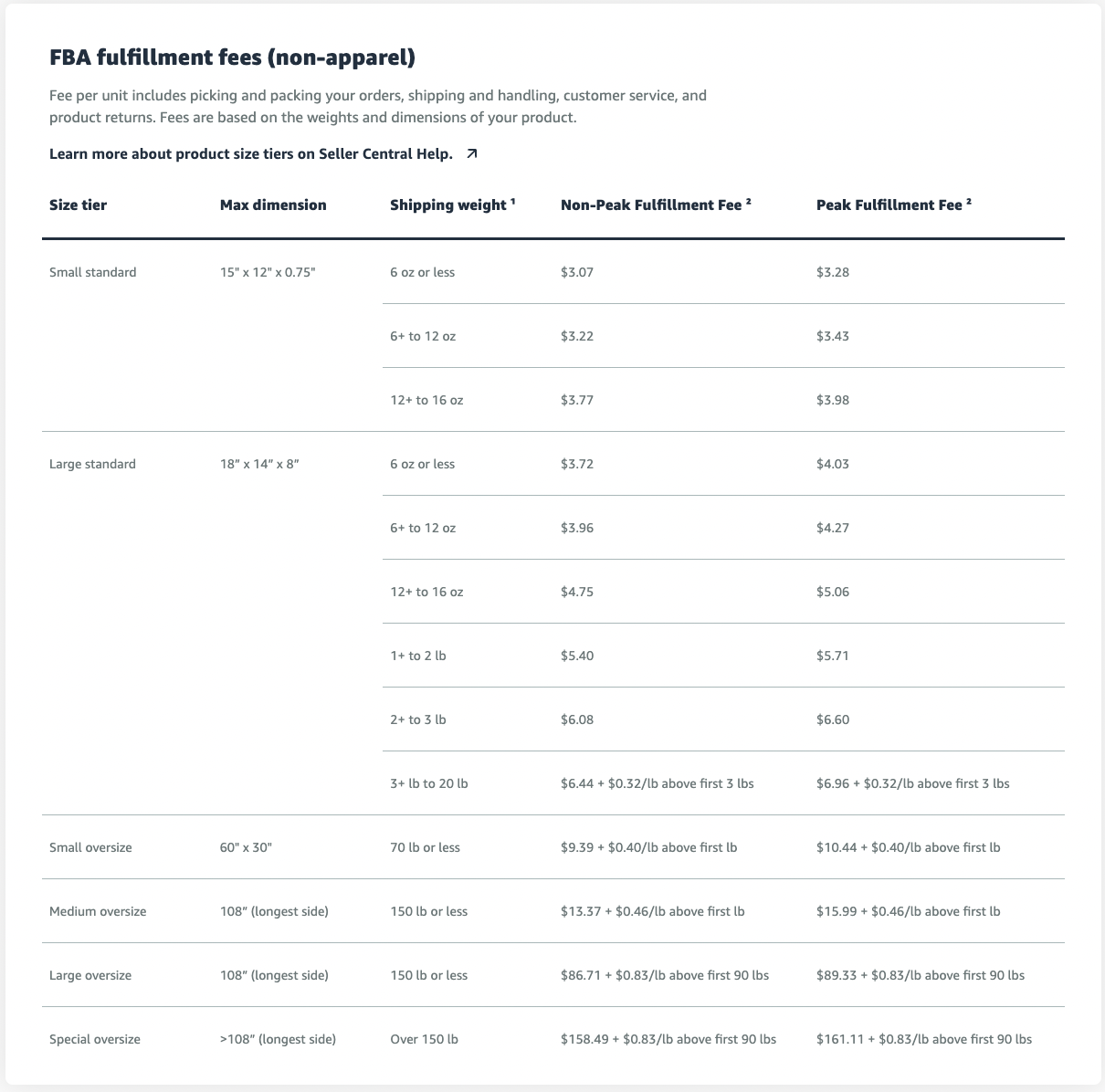
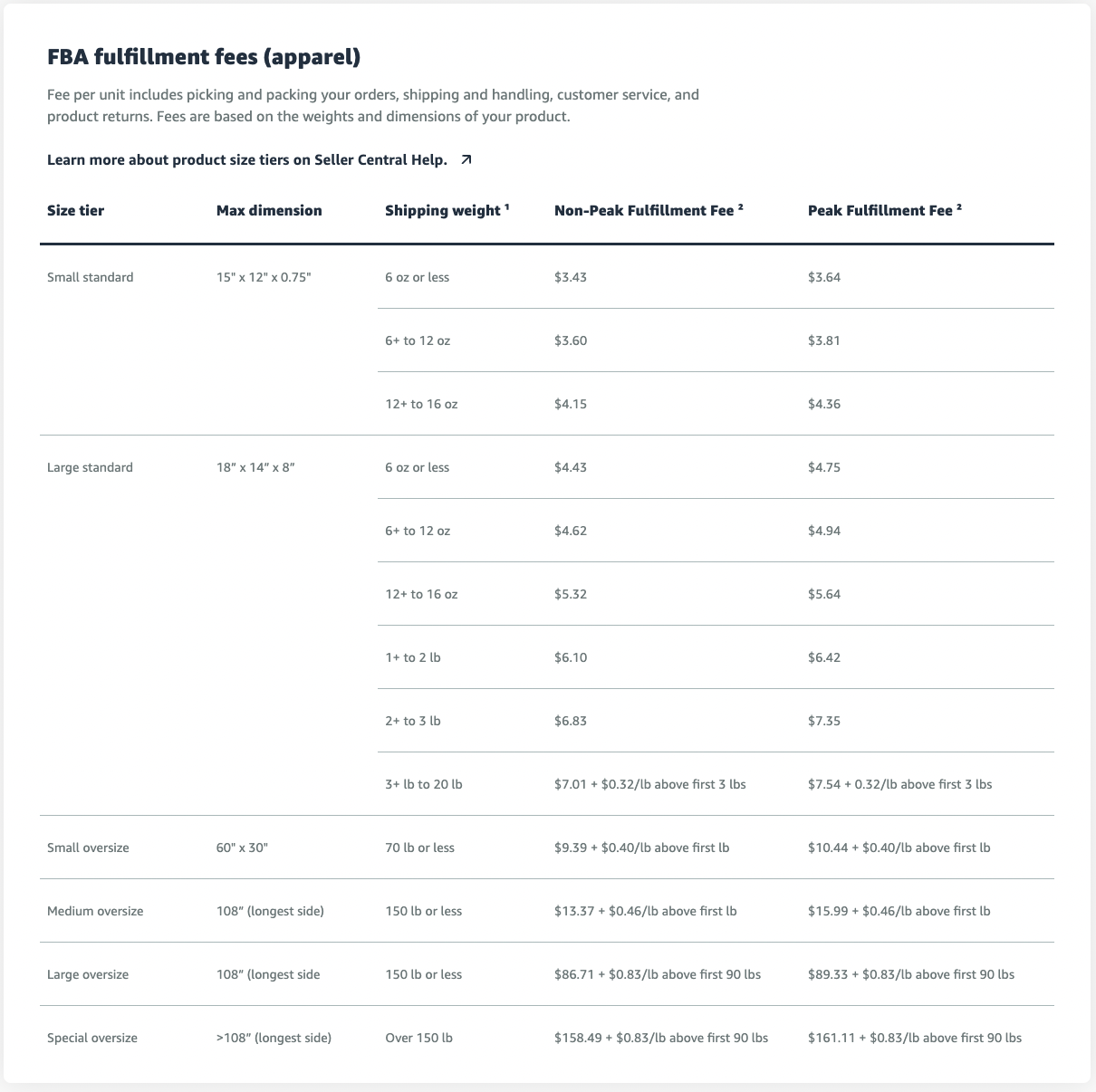
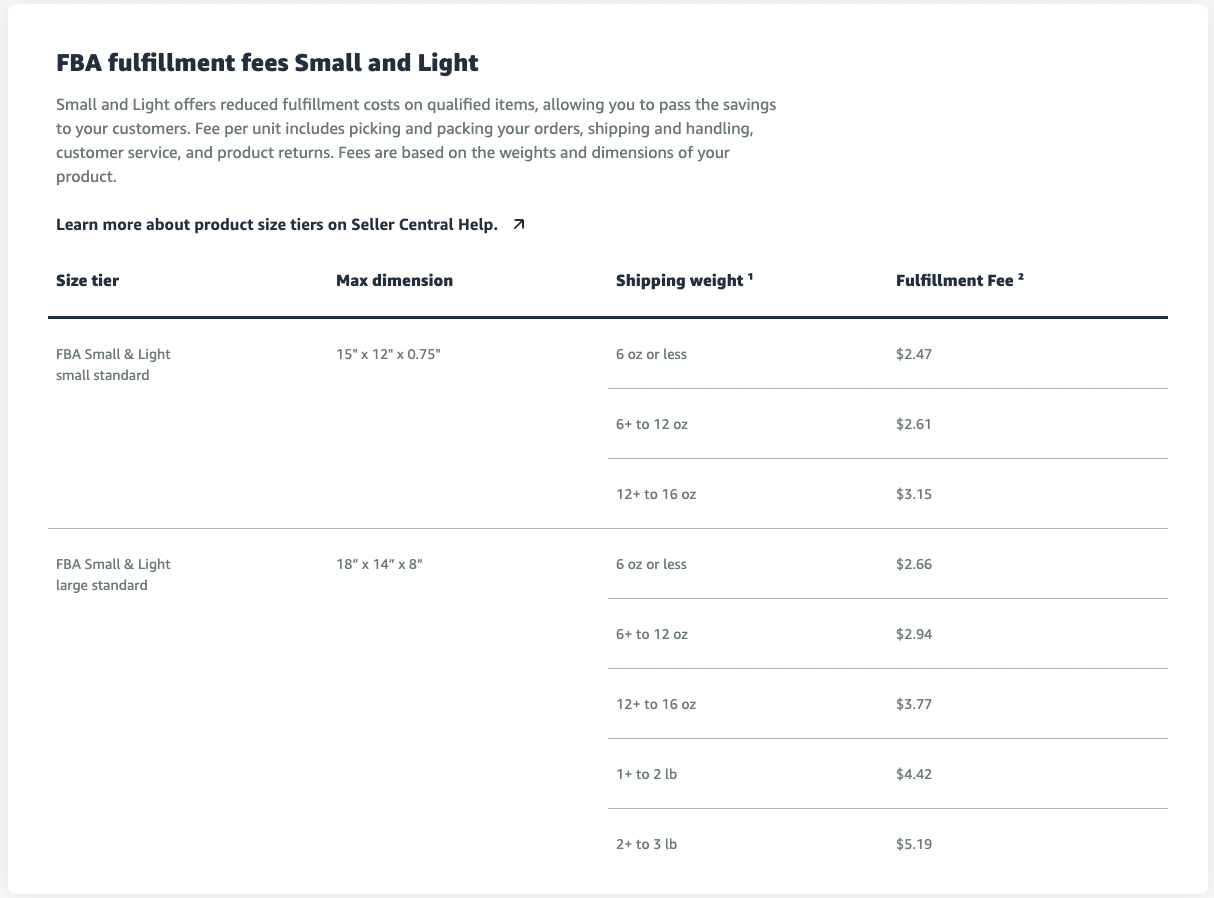
Note: Clothing, and items containing lithium batteries, have additional fees — $0.40/unit for clothing and $0.11/unit for Items containing lithium batteries.
FBA storage fees
Because your products are being stored in Amazon’s fulfillment centers, Amazon charges storage fees to maintain your inventory.
There are two types of FBA storage fees: monthly and long-term.
Monthly storage fees
If you have inventory in an Amazon warehouse at the end of the month, Amazon charges you a monthly storage fee. These are either subtracted from your account balance or added to your credit card if and when your Amazon account doesn’t have enough funds to cover the fee.
These are the current monthly storage fees for storing products in Amazon’s fulfillment centers:
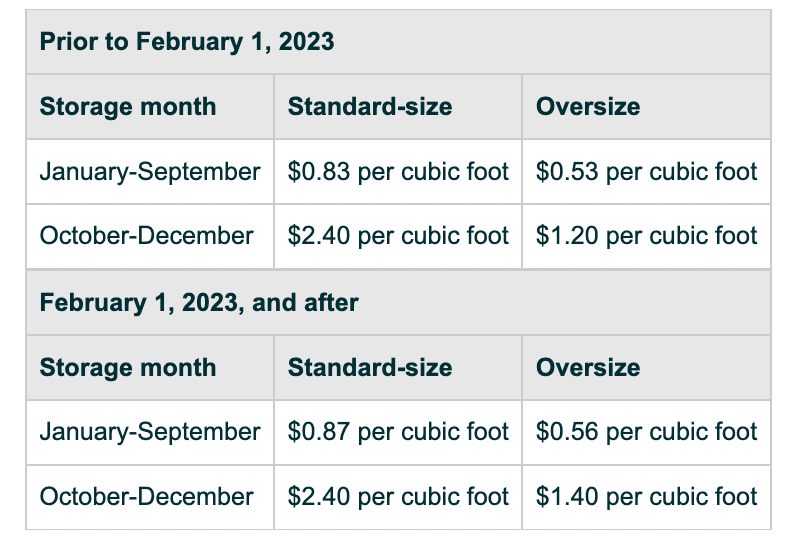
“Starting April 1, 2023, we will introduce a storage utilization surcharge for the monthly storage fee. The surcharge will be based on the storage utilization ratio, which is the ratio of your average daily inventory volume stored in cubic feet divided by the average daily shipped volume in cubic feet over the trailing 13 weeks. We will calculate the storage utilization ratio on the last day of a given month. This means that for inventory stored in April 2023, we will calculate the storage utilization ratio on April 30 and apply the surcharges in May 2023 storage fee charges.”
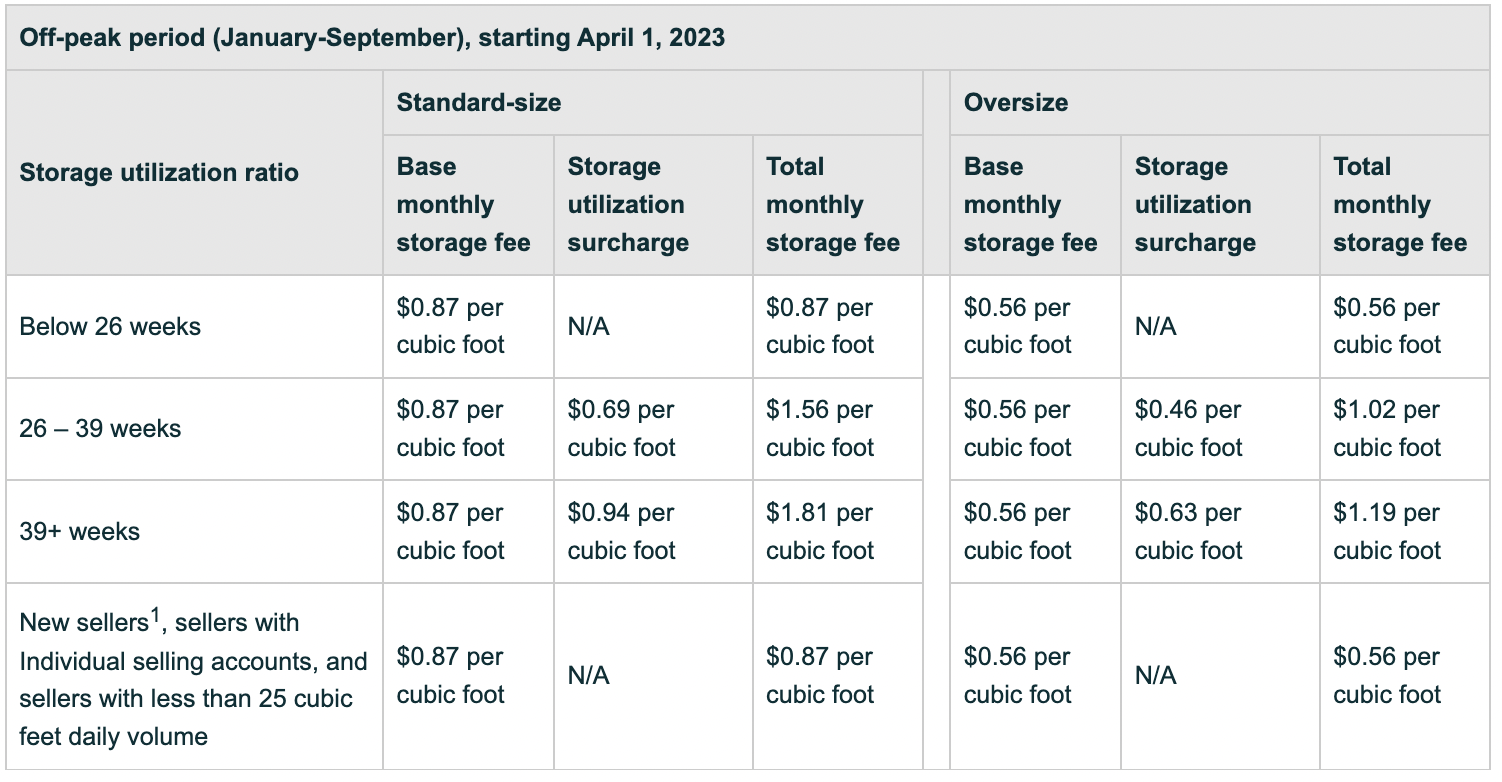
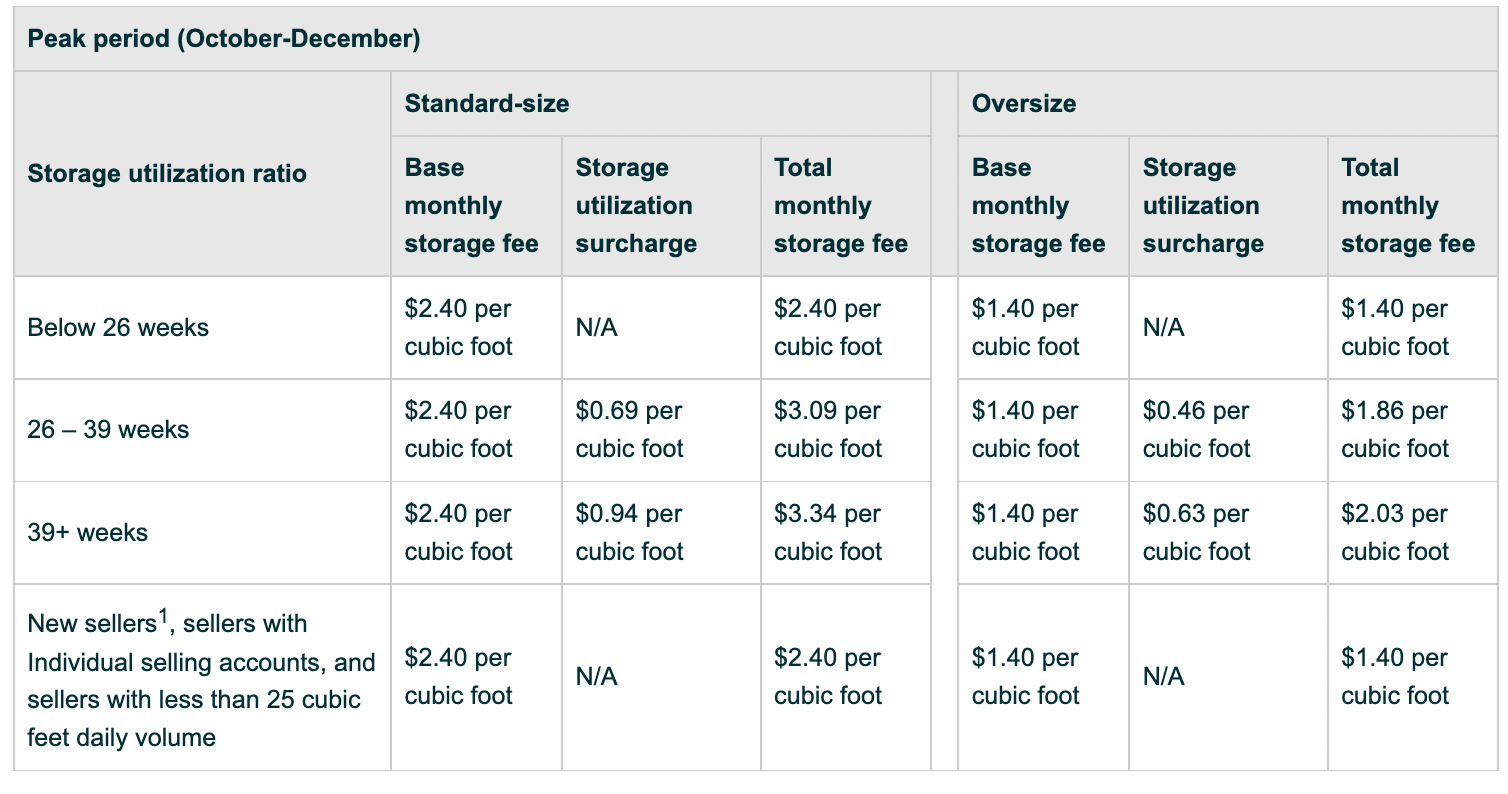
FBA aged inventory surcharge (previously known as long-term storage fees)
From Amazon:
“Starting April 15, 2023, we will increase the granularity and magnitude for the aged inventory surcharge (previously known as the long-term storage fee) on inventory stored between 271 to 365 days. Additionally, we will introduce new tiers to begin the aged inventory surcharge on inventory aged 181 to 270 days for all products except items listed under the clothing, shoes, bags, jewelry, and watches categories in the US. We will continue to charge an aged inventory surcharge for units that we store for more than 365 days.”
Amazon conducts inventory clean-ups on the 15th of each month. During the clean-up, Amazon records any products that have sat in their fulfillment centers for 181 days or longer.
For those items stored for 181 days or longer, Amazon will charge the seller an aged inventory surcharge, depending on the age of the products stored.
Like monthly storage fees, the aged inventory surcharge is deducted on the same date each month from your Amazon seller account balance or from the credit card which you put on file when you registered as an Amazon seller.
Note: During Amazon’s busy seasons, these fees will go up to persuade sellers to remove slow-selling inventory.
Fees that only FBM sellers pay
FBM sellers do not have their own separate fees like FBA sellers do. However, the costs to sell as an FBM seller are often higher than those of an FBA seller, since FBM sellers have to store, pick, pack, and ship their own products. They also have to handle their own customer service.
For example, if I were selling a stainless steel mug as an FBA seller for $30, I would pay $4.50 in referral fees and $5.06 in FBA fees.
If I were to sell the same product as an FBM seller, I would have to factor in the shipping costs (estimated at $6), and the cost of packaging (estimated at $1), bringing the total fulfillment cost to roughly $7 (This is before any labor or storage costs).
In this scenario, it would cost more to ship with FBM vs. FBA.
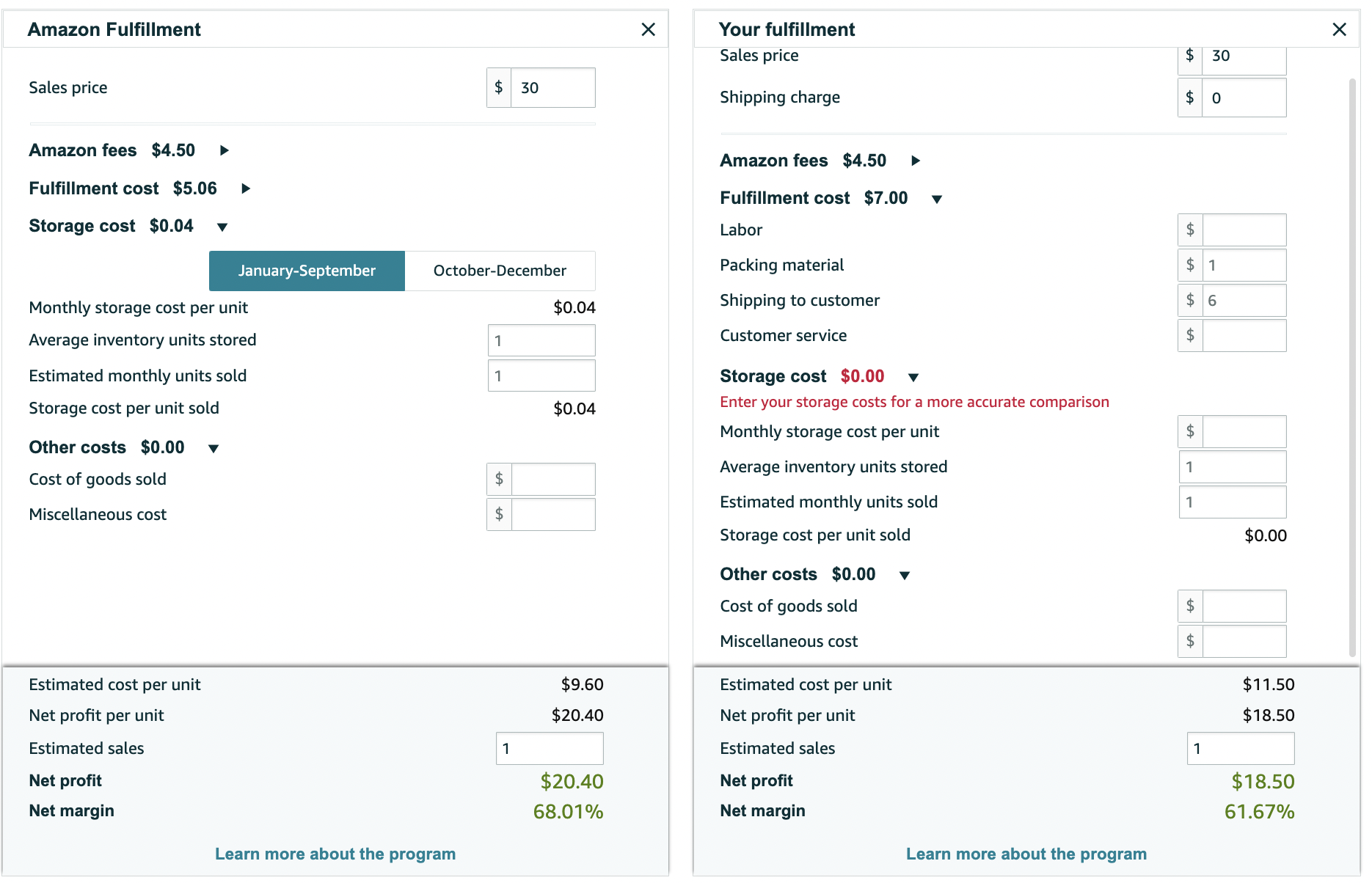
To compare FBA and FBM costs, check out Amazon’s free FBA Revenue calculator (pictured above).
Opportunity Costs: What does your labor cost you?
When choosing a fulfillment method for your business — Amazon FBM or Amazon FBA — you need to consider the cost of labor.
As an FBA seller, the cost of labor to ship your products is factored into the FBA fee. FBM sellers, on the other hand, must determine cost of labor by measuring their opportunity costs. (Opportunity costs are a way of estimating costs based on the time spent on an activity.)
The easiest way to estimate opportunity costs is to estimate what you would be paid on an hourly basis as an employee and then multiply that by the amount of time it takes you to perform the action.
For example, if you earn $40/hour at your day job and it takes you 10 minutes to fulfill a product that you sold on Amazon, the opportunity cost is $6.67.
So, while you aren’t actually paying a fee or paying someone else, it is costing you time, which costs you money.
Miscellaneous service fees
The last group of fees mentioned in this article are fees that only a few sellers must pay. These fees are paid regardless if you are an Amazon FBA or FBM seller.
Closing fees
Media products such as books, DVDs, CDs, and Blu-Ray, come with a flat $1.80 fee per sale, and only sellers who focus on selling these products need to worry about these fees.
Like the referral fee, the closing fees are deducted from the proceeds of the sale so you do not need to pay these fees in advance.
High-volume listing fee
Sellers with thousands of ASINs may be required to pay a monthly flat fee of $0.005 per eligible ASIN. But, unless you have more than 100,000 products listed, you won’t have to worry about these fees.
High volume listing fees are paid at the same time as FBA storage fees. These fees are deducted from your Amazon account balance. If you don’t have funds in your account balance, then the amount is deducted from your credit card.
Rental book service fees
Sellers who rent textbooks on Amazon must pay a $5.00 rental book service fee for each textbook rental that they sell.
Like referral fees, rental book service fees are deducted at the time of a sale and you will not need to pay these fees in advance.
Jungle Scout’s tools such as Product Database and Extension can help you estimate the fees you will need to pay for specific products. Click the link below to learn more.
How have Amazon’s fees affected your business? Were they a deciding factor in whether or not you chose to sell a specific product? Let us know in the comments below!
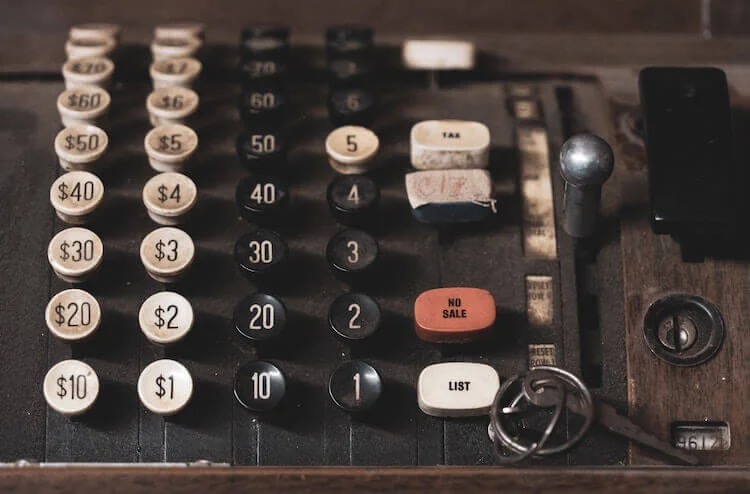

 106 Comments
106 Comments
106 comments on “Amazon FBA Fees: How They Work and How to Profit as a Seller”
You have offered some pretty valuable information. That’s all I wanted to say. Normally I don’t remark, but since I’m extremely new to selling on Amazon and want to know what my best option is, it has been useful.
So if I’m fba .. I can buy units at local stores and have them picked up and delivered to Amazon warehouse with printed ups barcode? Is it costly?
If you buy products from local stores, you will need to package the items, create a shipment in Seller Central, and ship them to Amazon. Typically, the rates are fairly cheap when using an Amazon-partnered carrier.
Thanks for your article, it was very informative! I just wanted to check that the Amazon FBA fees when selling on Amazon is different to when working with them solely as your fulfilment centre (for example, linking them with Shopify and getting them to fulfil your sales)?
Reason being, I currently sell my product on Amazon via FBA and the costs are very competitive. However, the Amazon FBA costs stated in this article are far greater.
Thanks for your help!
Wow! This post made me realize that Amazon has so many fees!!! Makes me wonder how does a person even make profit off selling something on amazon, if it doesn’t have that much value in the first place.
You have provided very helpful information. I just wanted to state that. I normally do not write comments but it has been helpful as I am very new to selling on amazon and what to see what the best option for me is.
By the time your finished as an individual, looks lie 40% is the amount you will pay to sell am item. What a long drawn out way to get boned.
Hello – does the calculator above consider the cost to ship the item to amazon warehouse?
Hi,
No, it does not. You’ll have to calculate that yourself. Though, inbound FBA shipping is usually pretty cheap when using UPS.
Hello! So, for books, it will be a 15% fee plus $1.80/book? Great article, very informative!!
Hi Rachel,
Yes, that is correct!
Do you pay to ship your items to Amazon warehouse for sale as an FBA?
Hi LT,
Yes, you will need to pay to ship your goods to Amazon as an FBA seller. Though the cost to ship is cheap if using Amazon’s partner carriers. When you create a shipment in Seller Central, you will be able to see how much it costs.
what is not covered in this topic and what I’m looking for the most also, the shipping charges to amazon warehouses from a foreign country? are there any calculator for that?
thanks
Hi Amila,
Check out this Youtube video by Jungle Scout that helps explain the process of shipping your products from China to Amazon FBA. https://www.youtube.com/watch?v=QwDYqTJNJbA
Hi Dave is the closing cost for selling books of $1.80 in addition to the other fees or in place of the 15% fee per unit. Also how does anyone make money if I sell a plush toy for $15.00 but with all these fees it totals $13.00 for instance, and I sell 1000 I make $2.,000.oo but I paid $6600.00 in ALibaba for 1000, am I understanding this right I am out 46$4600.00
Hi Deidre,
In this case, you need to either get the cost of your product down, or sell the plush at a higher price point in order to make a profit. If you are able to fulfill the orders yourself at a lower cost, that is an option as well instead of using FBA.
FROM AMAZON SELLER INFO’S
Can you explain more about the standard size? why are there different prices based on months? Opening up a business on Amazon? helpful tips would be appreciated
Hi Ahmed,
Standard size will be the lowest cost FBA fees on Amazon. If your product falls somewhere in standard size, this is better for profitability in most cases. Oversized products will cost much more in FBA fees. Storage fees will increase during the holiday season, that’s why you see a price difference.
Very helpful for someone just considering selling on Amazon …thank you!
We’re glad you found this article helpful! Thanks for reading, Garth.
– Brian
How have you come up with “ the time it took to ship it ($6.67)” amount? That doesn’t mean anything to me.
Hi Clay,
He was referring to the “opportunity cost.” Read the section below the FBA calculator example.
Hello Dave, thank you very much for this article, very helpful.
I do have a question regarding Amazon’s LTSF though. I understand from the article, that the LTSF are applied to products that have been on Amazon’s warehouse for 180+ days.
“Long-term storage fees
Amazon conducts inventory clean-ups on the 15th of each month. During the clean-up Amazon records any products that have sat in their fulfillment centers for 180 days or longer.
For those items stored for 180 days or longer, Amazon then charges the seller a Long term storage fee, which is $6.90 per cubic foot of storage used. ”
Although, I was reading the Help section from Amazon Seller Central, and came across this information from Amazon:
“The Long-Term Storage Fee is assessed based on the total volume in cubic feet of units that have been stored in Amazon fulfillment centers for at least 365 days. Per SKU amounts are calculated as: (12-mo-long-term-storage-fee) = (12-mo-qty-charged-long-term-storage-fee) x (per-unit-volume) x $6.90 (charge applicable beginning with August 15, 2015, fee assessment).”
What’s your opinion on this? Are we being charged for items that are 180+ days old or 365+ days?
Thank you, regards.
Hi Roberto,
Thanks for pointing this out! It is 365 days.
I have a ? about shipping fees with fba. If I sell something through fba with free shipping so it is qualifies for Prime shipping, do they charge me additional shipping fees on top of all of the FBA fees discussed above? Thank you so much! Right now it is looking like I would have 30% fees on a $27 item which is fine but if then they take shipping out on top I have a problem with my pricing.
Hi Jen,
The FBA fees will include the shipping costs to the customer so you will not be charged anything more than that per order.
Hi David, my questions is Amazon has warehouses national wide, so if we use FBA, do we need to just ship our goods to one of its warehouse that is closest to us and Amazon will ship to customers in different locations at the same FBA cost when ordering the same goods?
Hi Don,
When creating a shipment in Seller Central, Amazon will tell you where to send your goods. Usually, it’ll be close to your location but they may have you send to multiple warehouses.
You can choose to have all your inventory sent to just one warehouse where Amazon will then split them up and distribute inventory across the country. But that comes at a cost. It is called “Inventory Placement Service.”
I am a regular visitor of your website and this article helped me a lot. Thank you
Hello,
My company is considering selling on Amazon and there are a couple issues that I’m not clear on (tried finding answers on Amazon w/o luck):
1. The shipping charges that consumers are assessed (if any) are set by the seller/retainer, right?
2. Any any shipping charges that consumers pay are forwarded by Amazon to the seller/retainer, correct?
3. If the seller/retailer charges, say $3 for shipping and the consumer is an Amazon Prime customer (and therefore gets free shipping), what happens to the $3 fee?
3b. Amazon bears the shipping cost, right?
3c. Does the seller/retailer therefore receive the $3 from Amazon (i.e. comes out of Amazon’s pocket)?
Thanks to anyone that can provide information on the above!!
Are Amazon Fees reduced if you have a sale going on with a discount code applied at check out? ie are the fees based on your listing price, or the check out price after the discount is applied by the customer?
Hi Carmen,
That is a great question! The Amazon Fees are determined by the final sale price of an item. So if you offer a discount code, you will pay fees on the price the customer paid after the discount, not the original price.
Thanjs a lot for Detailed information.
What are risks involved for new start up entrepreneurs.
How much investment requires approximately if I am planning initially
Hi, all is going nicely here and ofcourse every one is sharing facts, that’s
really excellent, keep up writing.
wish this fees would be itemized and not just put in the statement as “amazon fees”. Im a month in selling on amazon but the fees really hurt. The small sellers are the ones that hurt. Doing retail arbitarge does not give any profit at all because of all these fees after your product sells. so shocked, feels like we shopped for amazon for them to sell and get the profit. dont know what we are doing wrong
Hi Sassy,
I understand the issue you are experiencing! You really need to learn and understand ALL of these fees associated with selling on Amazon. You need to ensure the products you are buying to resell have enough margin. Are you using to Amazon seller app to scan for items?
It is truly a great and helpful piece of information. I am glad that you shared this helpful information with
us. Please stay us informed like this. Thank you for sharing.
I am kind of confused. If you want to do the monthly FBA it’s fee is $39.99, plus a referral fee of 15% or less (depending on the product) plus a storage fee , plus a size fee? Am I adding that right? It kind of seems like a lot of fees.
Hi,
Yes, that is correct. That’s why it is very important to understand all of Amazon’s fees before selling anything. The pro account is $39.99/month, plus the referral fee, fulfillment fee, and monthly storage fee.
Thank you Brian, this is very helpful. Am I correct in saying that the Amazon Fee calculator for FBA includes everything except the $39.99 monthly fee and the monthly storage fee (calculated by Cubic ft)? Basically, the FBA calculator is only giving me the referral fee and fulfillment fee costs, right??? Seriously appreciate your help. Thank you very much!
Hi Sarah,
Yes, that is correct! You can add what you think the storage fees will be within the FBA calculator.
Enjoyed reading this, very good stuff, thank you.
I’m confused about the FBA. To sell on Amazon I pay them a commission (referral) fee of $4.50 (15% of $30), which is fair. Then if I chose FBA option, Amazon would charge me $12.44 to fulfill the shipment, including shipping, packaging, customers service. Yet they also charge the buyer shipping cost. Does that mean they get paid from both buyer and seller for the shipping cost?
The total fee/cost (referral + FBA) that Amazon charges for this item is $16.94. In another word they take a cut of 57% off the item price. That means if I bought this item at the price of $15 to sell on Amazon, my net revenue would be -$1.94. Yes, I would LOSE $1.94 for all the work. Does this sound right to you?
If I chose FBM, would I get the shipping cost back which Amazon collect from the buyers? If so, at least I only have to spend $3 for packaging out of my pocket and the time for me to send it. I don’t really understand what the $6.67 is for when you said: “the time it took to ship it ($6.67)”). My net revenue would be $30.00 – $4.50 – $3.00 = $22.50. If I bought the item at $15, I’d make $12.50. Would that be a better bet than the FBA?
Ideally if I sell the items directly (on my website or from my own store), I would charge the buyers the shipping and handling fees. Say the item price is $30 as you already suggested above. Shipping and packaging cost $11.00 ($8 shipping + $3 packaging according to the rate on the chart above. The total the buyer would pay is $41.00. I still get the net revenue of $30.00. If I paid original price for the item of say $15, I make a profit of $15.
Anyone here has an opinion about this?
The fulfillment fee will be based on the weight and dimensions of your product. If that seems high, contact Amazon to remeasure your product. To me, that seems a little high but you may be selling a larger product.
Hi, I’m speaking with Amazon next week to finish my setup to be an FBM seller. Can I charge whatever I want for shipping? Also, when you set up your account, does it only set you up to sell to the United States, or am I setup to sell globally?
Appreciate all of your help!
Thank you
Michelle from APA Cosmetics
Hi,
Yes, you can set your own shipping rates though I suggest offering free shipping on Amazon.
You will only be set up within the US.
Am I missing something? Because it would seem that regardless if I FBA or FBM used books, I still pay shipping costs because I’m either shipping the books to Amazon for storage or i am shipping the books directly to the buyer.
Hi Darren,
Yes, you do have to pay to ship the books to Amazon. But the shipping costs are very, very low. If you’re shipping multiple books into FBA, you’ll pay roughly .25 to .50 per book. Maybe even less.
How have you come up with “ the time it took to ship it ($6.67)” amount? That doesn’t mean anything to me.
Hi Matt,
This is an example of labor costs. That section in the FBA revenue calculator allows you to break down your specific costs so that may not apply to you.
Very informative article. Thanks Again. Will read on…
Thanks so much article answered so many questions and easy to understand.
One Question though: how is the delivery charge factored in?
If i sell a book for $6.50 on amazon thru FBA i calculated i would get $0.50 profit (see calc below) after all costs u have described. However If $2 is charged as delivery then i would get 0.50+2 = $2.50 profit which is viable.
Profit (approximates) = $6.50-$1 (15%) -$2.50 (FBA-individual) -0.33 (storage) -1.80 (flat fee media)-$0.40 (courier to send to amaz center) =$0.50 ie zero profit except to Jeff!
My Question another way , if we use FBA then who gets the delivery fee? How about if they have no fee they are prime?
Thanks in advance for answer!
Hi Moses,
If you are selling via FBA, you will not receive a shipping credit from Amazon.
A sale price $10 or below is typically not worth it.
Very good article. I am going through some of these issues
as well..
Wondering if my listing is inactive, as have run out of stock, am I still charged storage fees? … Or do I need to delete my listing to avoid stor fees? Cheers.
Hi Satty,
If you have no stock available in Amazon’s warehouses, you will not be charged storage fees.
Hello, I’m a bit confused and hope there is an easy explanation for me. I am listing and shipping books from home, not trying to start a business and I am not having Amazon fulfill the items, and the fees seem unusually high. For instance, I am listing a comic book at $6.99 + $3.99 shipping and the estimated fee per unit sold is $4.44. That is almost half. I have another book for sale at $23.99 plus shipping and the estimated fee is $6.99. I truly do not understand the estimated fee per unit sold.
Thank you!
Hi Linda,
For low priced items like your first example, the fees will eat up a lot of your profit. The fees if using FBM, will be 15% for books every time. With media items (books), you will also pay a closing fee of $1.80 per media item that is sold.
Use Amazon’s FBA revenue calculator to get an accurate estimation.
Hi, thank you for the article. This is great information and well put together. I live in Canada and intend to utilize FBA for selling my line of clothing. The question I have is…does Amazon help with Customs Clearing and Forwarding if I get the Clothing shipped directly to the Amazon Fulfillment Center or is the Customer Clearing and Forwarding my responsibility. Thank you!
Hi Abbi,
Customs and forwarding your inventory is your responsibility.
Just simply put amazon TAKES minimum 40% of GROSS sale . this is not counting if you buy their advertising tool. You may lose money if you dont pay attention.
Quality articles is the crucial to attract the people to visit the website, that’s what this
website is providing.
Nicely done & written!
I began writing a blog recently and noticed that manyy blogs simply rework
old ideas but add very little oof value. It’s fantastic to read an educational
article of some genuine value to your readers
and I.
It is going down on the list of details I need to emulate as a new blogger.
Audkence engagement and material value are king.
Some superb thoughts; you’ve unquestionably made it on my list of blogs to watch!
Carry on the excellent work!
Well done,
Aldwin
I like this blog it’s a master piece! Glad I detected this on google.
Great! Glad you enjoyed it.
Hi, I’m super new to this. I actually just had a few specific questions, say I wanted to ship to Amazon, sports equipment to sell, how much would it cost to ship. Also how do I go about advertising the product, should I use, PPC or another method.
Thank you
Hi Adedamola,
Thanks for your questions! The cost to ship all depends on where you are shipping from, to which Amazon warehouse, as well as the size and weight of your shipment.
Amazon has very cheap shipping rates with UPS but that question is impossible to answer without setting up the shipment in seller central.
The best way would be to do PPC. It is a great way to get your new products in front of new customers.
Thank you for your time and enegry to put this Informative article together. If after 180 days, I realize I realize too much inventory is with Amazon, can I request some of the inventory be forwarded to my shop?
Looking forward to your reply.
Hi Hikai,
Yes, you can. You are able to set up whats called a “removal order” to have some inventory sent back to you.
-Brian
Well done. Exactly what I was looking for. Appreciate the time you spent putting this together.
I have some confusion regarding storage fees. For example storage fee is 0.69$/cubic meter. If i have small item & its 20 pcs can be cover in 01 cubic meter. Then will i pay 0.69$ for all 20 pcs or i will pay 0.69×20=13.8$.
Hi Basit,
In that case, you would pay 0.69 cents for the 20 units if that is the only space your products take up.
Hi, this weekend is good designed for me, for the reason that this moment i am
reading this enormous informative paragraph here at
my home.
Great! Did you find it helpful?
information was sufficient and very helpful.
Glad you found it helpful!
I wish more FBA sellers read this article or do some math because I doubt a lot are making any money. The FBA model is so complex and loaded with fees.. Hard to calculate in advance what a sale costs since you are paying percentages but also monthly fees. On some products that we FBM and compete with FBA sellers, we know for a fact that they lose money on every sale. Which leads me to believe that unless you are ripping people off to make up the fees, you have no business in FBA…unless of course you are clueless.
Dave, this was a very useful article for me. Your description of selling on Amazon as having a stall in an international bazaar was great. I am wondering if you have considered using Amazon as a marketing strategy to get your products “out there” (alongside other methods). Is there any restriction placed by Amazon to prevent sellers from using another e-commerce platform to sell the same product?
Hi Allan!
You can sell your products on any platform you please. You are not restricted to just selling it on Amazon.
– Brian
Thank you so much for this article, I found it incredibly helpful in doing research to see if this would be a good selling platform primarily for shoes. I understand that some items must be vetted, or approved before sale, and shoes appears to be one of them. How does this process work? Is there a link or an article I can check to get more details on this process? Thank you so much & have a great day!
Hey Bethany! Thank you for reaching out about this, as certification requirements vary based on the product you’re planning to sell. And while we don’t have an article that goes over those different processes, the Consumer Product Safety Commission has a post that you might find useful: https://www.cpsc.gov/Business–Manufacturing/Testing-Certification/General-Use-Products-Certification-and-Testing
I hope it helps!
All of their fees are the reason why I have no want of going through them for business. It’s outrageous. I noticed each item I sold, a huge chunk of it would go to Amazon. There were times when I would use the FBA calculator on items and Amazon fees were literally more than the selling price of the item! I understand they charge fees for doing work and taking care of the customer. But their fees are outrageous! I have a pie chart created on my bookkeeping software to show my income, expenses, taxes ect. 90% of that chart was Amazon fees and they went up on their fees this year. I’m sure it’ll go up every year. Amazon puts a bad taste in my mouth and I will never be affiliated with them again. It’s a huge crooked greedy company. It’s nice and convenient for the customer but try working for Amazon. Weather it be a warehouse worker or a third party seller. You’ll learn that this huge company is only about money, power and reaching it’s greedy sticky tentacles as far as they can go. That greed will be their demise.
Where are the footnotes? I sell a game which has a footnote of “2,” under fees and I can’t figure out what it is. Thanks.
Lisa,
I’m not sure what you mean, could you show me an example?
Thanks!
Hi, and thanks a lot for this information!
However I have some more questions: I want to sell a book with weight slightly under 2 lbs. My books (and I) are in Sweden. If I use FBA – will I then have to pay for shipping some books to Amazon? Do you know if there are taxes or other additional costs to this?
Hi Len,
If you’re going to use the used book model, I suggest selling books via Amazon EU. While I’m not totally familiar with all of the fees there, I do know that EU sellers typically have to worry about the VAT when they sell products. Likely, you will have the same fees as in the US such as the media fee and referral fees.
hi, thanks for very useful info. we want to sell small children books 210 x 210 and weigh only 3.2 oz. am i correct in thinking that these will cost $1.80 each to sell and post FBA plus storage. Also, we are in the UK so how does it work and what is the cost if people in the USA or Germany for instance want to buy our books on FBA. thanks again for your very useful site. peter
Hey Peter,
In the UK, you have to consider the VAT. I think that you can still send the books through the Europoean fulfillment chain (despite Brexit), but you might check with seller support there just in case.
Is the FBA fee discounted if you have multiple units per order? thanks.
Rip,
Great question. I don’t believe so, no.
this is exactly the details i was looking for in my google search for amazon fba summary. the fees seem pretty high on your $30 item, nearly 50%, they make far more money than the guy who takes the risk buying the inventory.
Robert,
It depends on the item. Usually the fees come out to around 25-30% if you include the FBA fee. But the FBA fee shouldn’t be thought of as a fee more than it’s the shipping cost you’d have to pay either way.
HI,
Thank you for such valuable information put all together. Appreciate a lot!!! I am not being able to proceed from product listing. I asked for GTIN exemption for my product and was approved for the same. NOw when I try to list my product, Amazon does not allow it and keeps on saying product information missing (but does not specifies what kind of information). Its been a month since I tried to list the product. It is in the draft but I could not complete it. My product is also provided with an SKU number. Now, I feel like I am nowhere. If you know something, please help me.
Hey Sha,
Sorry to hear about the issue. Hopefully we can help. Where did you purchase your UPC? We’re finding more and more that UPCs not purchased through GS1 are being rejected by Amazon.
If the issue persists, contact our Customer Success team here on Jungle Scout and they can help you navigate the issue.
Great Value!! Thank you for taking the time to put this article together. It was an easy read with lots of helpful tips to understand the FBA program.
This article is very helpful ,thanks
Hi i want to know when i sell product on amazon fba should i pay all the fba fees before i start selling or amazon will automatically substruct the fba fees after every purchase .
Thank you for response
Hi Jhon,
Great question!
The only fee you’ll pay ahead of time is Amazon’s subscription fee if you’re listed as a professional seller. Otherwise, the fees are subtracted from the purchases and taken out of the amount they award you every two weeks.
Hope that’s helpful.
Thank you this is soo helpful!!!
Thanks for this useful information.
Hi, thanks for the post – very useful information. The illustration given above on 300 standard size items being sold per month, the FBA fee has been shown as 975$ which means 3.25$ per unit, which is in contrast with the information of 2.41$ per unit in the given table. Am i missing something?
Also, the storage fee, is it charged only after a unit has been sitting in warehouse for full 30 days or is it also charged on the unit which was sold on day 1? Thanks.
Very nice and informative. Thank you.
Great breakdown.
I especially appreciate that you wrote “net revenue” and not “net profit” which is the terms that gets thrown around way too much and causes a false picture of how much the profit really is.
Since net profit is after operating expenses and after taxes, it’s a very important distinction because I’ve seen a lot of sellers things they will “net” 35% but after paying for other expenses and taxes, they are either breaking even or losing money.
I find this post to be very informative and feel that due to Amazon seller’s confusion and/or being misinformed regarding Amazon Seller fees, many sellers just avoid the entire selling platform or just sell as a “hobby.” I’ve been guilty of this myself as it’s way too confusing to me so I’ve just sold intermittently on Amazon and eBay. Thanks for posting this, it IS VERY HELPFUL.
It was very helpful, thanks a lot